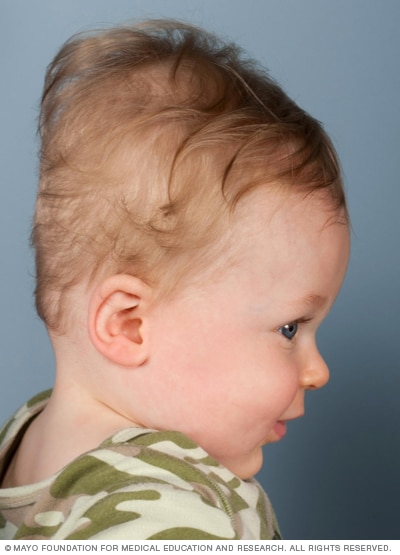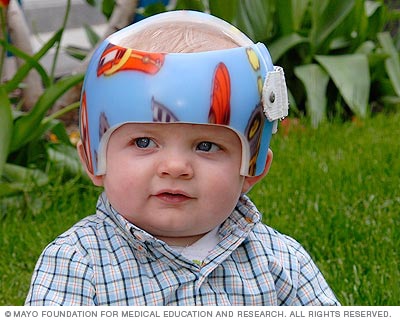Baby's head shape: Cause for concern?
A baby's head is easily molded. Know why and learn how to care for flat spots.
Updated: 2025-02-01
Many newborns have slightly uneven heads. But is it cause for worry? Understand what causes unevenness in babies' heads and when treatment is needed.
What causes a baby's head shape to appear uneven?
The bony plates of a baby's head are not rigid like an adult's skull. This flexibility allows the baby's head to flex during birth. It also allows an infant's brain to grow in the first year when the brain typically triples in weight.
A baby's head can look uneven due to:
- Crowding in the womb, as with twins, for example.
- The process of being born through the birth canal, especially during difficult birth or if forceps or vacuum extraction is used.
- Uneven pressure on the head.
There's nothing a pregnant person can do to prevent an uneven head shape due to the position of the baby in the womb. If the uneven head shape is caused by birth, it often gets better in about 6 weeks.
Uneven pressure on the head is most common in the first few months of life. Newborns are often in seats, carriers or swings without the ability to move around or sit on their own. And babies born early or with medical needs may have to lie mostly in one position.
The medical name for uneven head shape due to a baby lying in one position depends on the head shape.
- Plagiocephaly, when the back of the baby's head is flattened on one side.
- Brachycephaly, when the back of the baby's head is flattened making the skull wider than typical.
Rarely, two or more bony plates in the baby's head can join and become rigid too soon. This pushes other parts of the head out of shape as the brain grows. This condition is called craniosynostosis. It can appear on its own or as part of a medical condition or syndrome.
Is an uneven head shape cause for worry?

Positional molding
Because a baby's skull is malleable, a tendency to rest the head in the same position can result in an uneven head shape. The back of the head might look flatter on one side than on the other. This is known as positional plagiocephaly.
Flat spots caused by how a baby often lies don't lead to problems with development or brain growth. If the skull shape leads to jaw or vision problems, treatment may be suggested.
During a check-up, your baby's healthcare professional looks for uneven head shape. The healthcare team may measure your baby's head, look at the shape and make sure the baby's bony plates aren't joined together, called fused, too soon. If there are concerns, the team may suggest imaging tests.
How is an uneven head shape treated?
Rarely, a baby's head shape becomes uneven when the bony plates in the baby's head join too early, called craniosynostosis. To give the brain enough space to grow and develop, surgery may be needed to separate the fused bones. For mild craniosynostosis, a helmet might be used to change the shape of the head.
Usually, though, a baby's uneven head shape is caused by how the baby is positioned. To treat this condition, your baby's healthcare professional may suggest to you how to position the baby when laying the baby in the crib.
- Continue to place your baby on the back to sleep but switch the direction your baby's head faces in the crib.
- Hold your baby upright to help relieve pressure on your baby's head from swings, carriers and infant seats.
- Switch the arm you use to hold the baby and switch arms when you feed the baby.
- With close supervision, slowly increase the amount of time your baby spends on the tummy when the baby is awake.
Your baby's healthcare professional also may suggest physical therapy to treat head unevenness. This may be linked to a condition called torticollis, in which the neck muscles are tight. Torticollis often shows up as your baby having a preferred side to turn the head.
Physical therapy involves exercises to help change a baby's preferred head position and strengthen the neck and head muscles.
Helmets and head shape

Molded helmet
An infant's skull is easily molded. If necessary, a molding helmet might be used to help shape a baby's head. The helmet is worn at least 23 hours a day during the treatment period — often several months or even longer.
If your baby's head shape is still uneven by age 5 months, your baby's healthcare team might suggest a molding helmet or band. These are custom-fitted devices adjusted weekly as the skull shape changes. The device is worn for all but 30 minutes a day.
Molding helmets seem to work best for babies ages 3 to 6 months old. At this age, changing the shape of the head may take about 12 weeks. Changing head shape in children up to age 18 months is possible, but the process may take longer.
Checking your baby's head
Your baby's healthcare professional may measure the baby's head at each appointment. But caregivers can take a look too.
The baby's head should be evenly oval, like the shape of an egg, as you look at the top of the head. When you look at the ears, they should be at the same height and width from the front and back of the head. And the baby's forehead and head should be even, without cheekbones or forehead further out on one side.
If you're concerned about your baby's head shape, talk with your baby's healthcare professional.